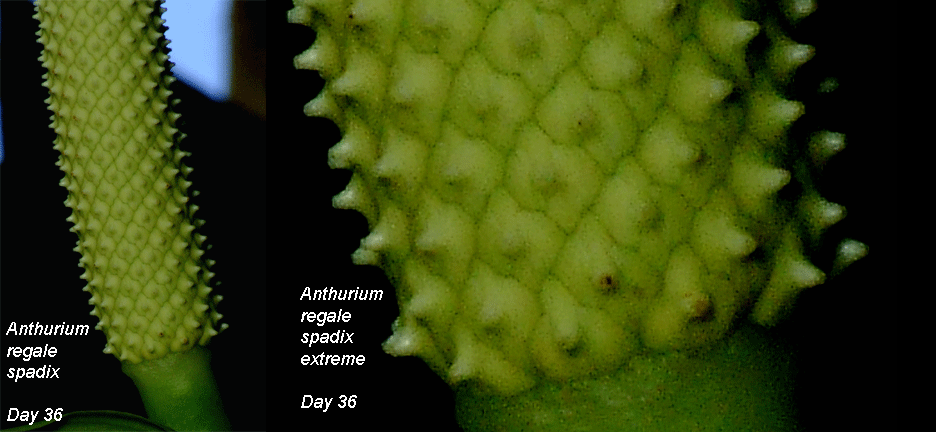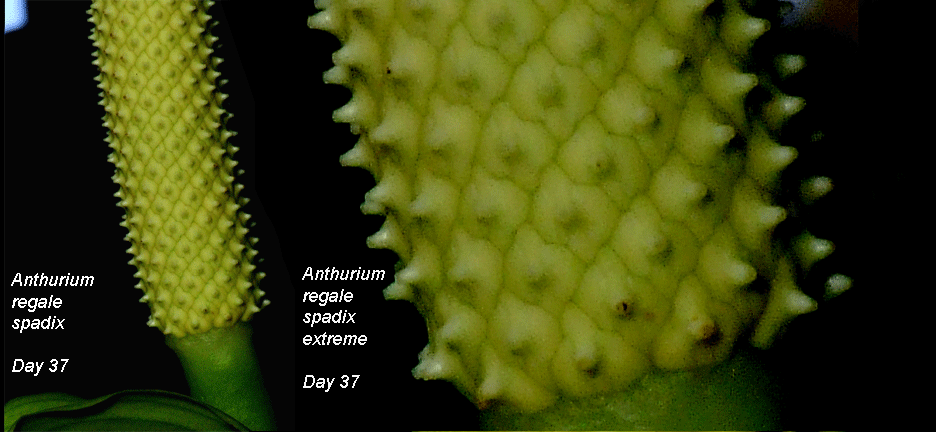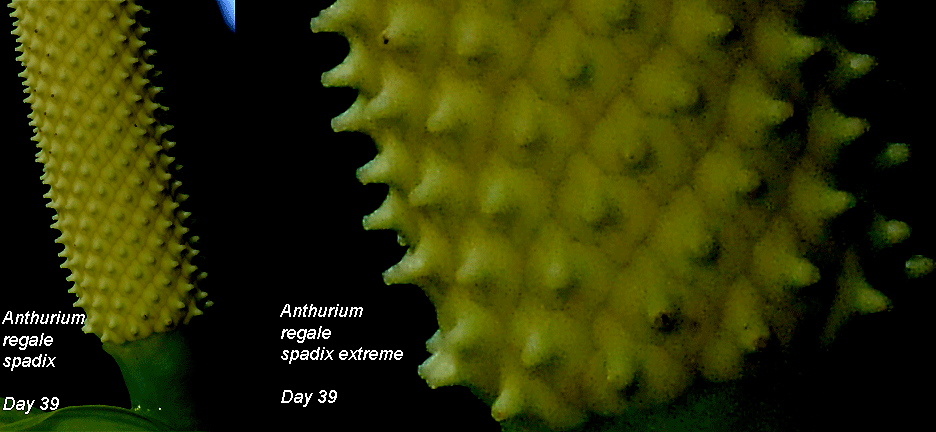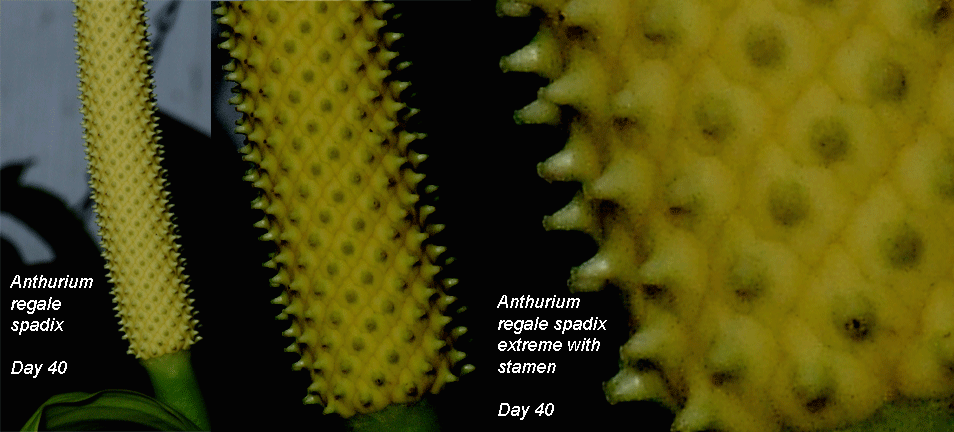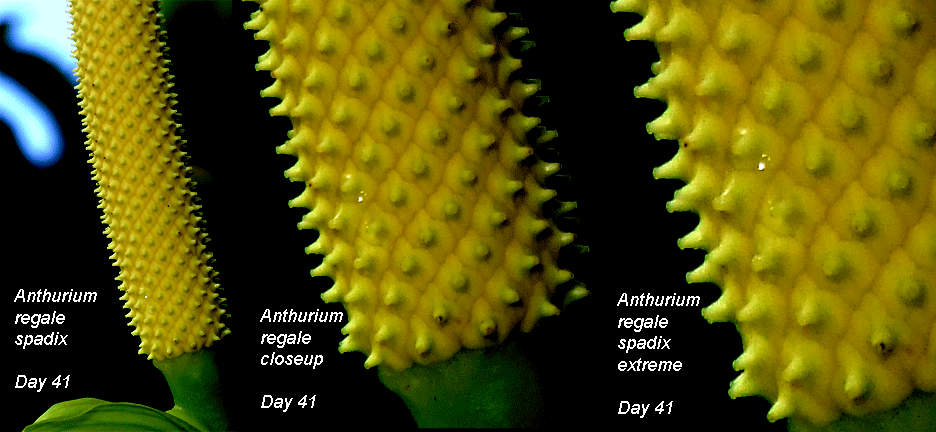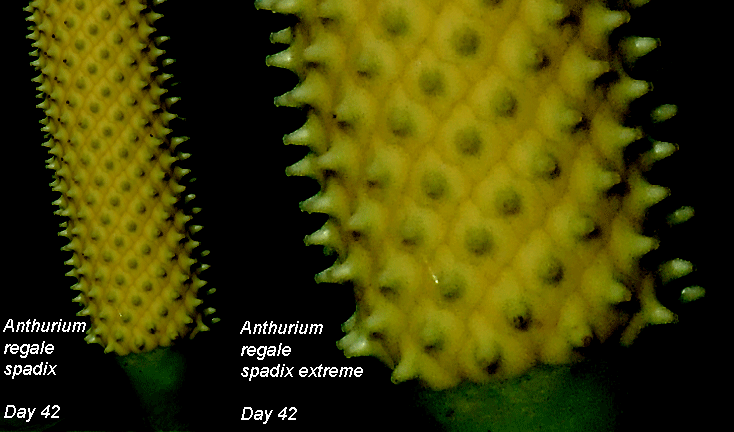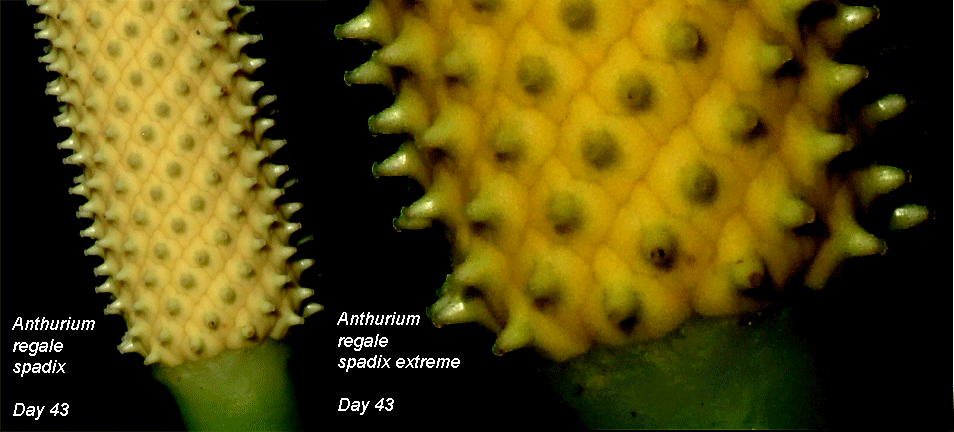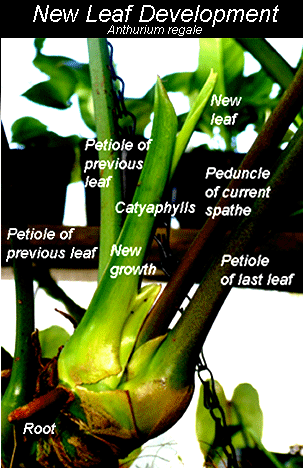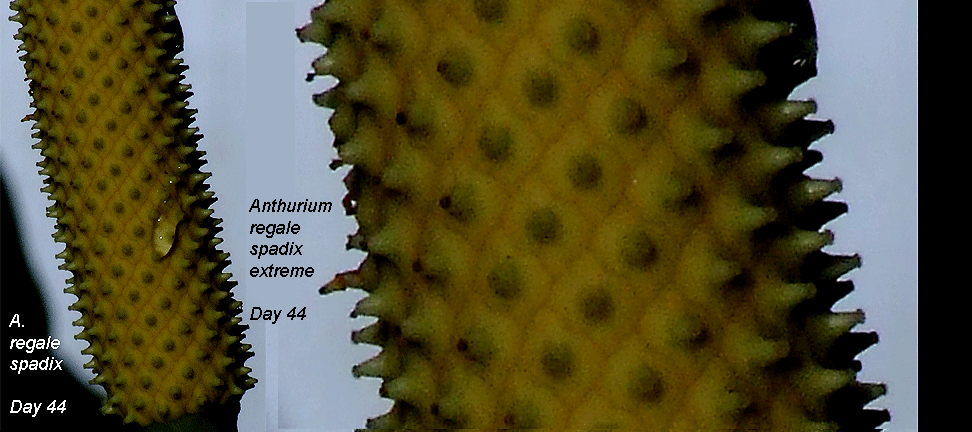![]()
Aroids and other genera in the Collection
Take the Tour Now?
Orchids
The
Exotic Rainforest
Plants in
the Exotic Rainforest Collection
Images on this website are copyright protected. Contact us before
attempting to reuse.
Anthurium regale
Linden
Growth of an
inflorescence
Please note:
This page contains numerous photographic images.
If you are using a dial-up connection the time may be longer
than expected.
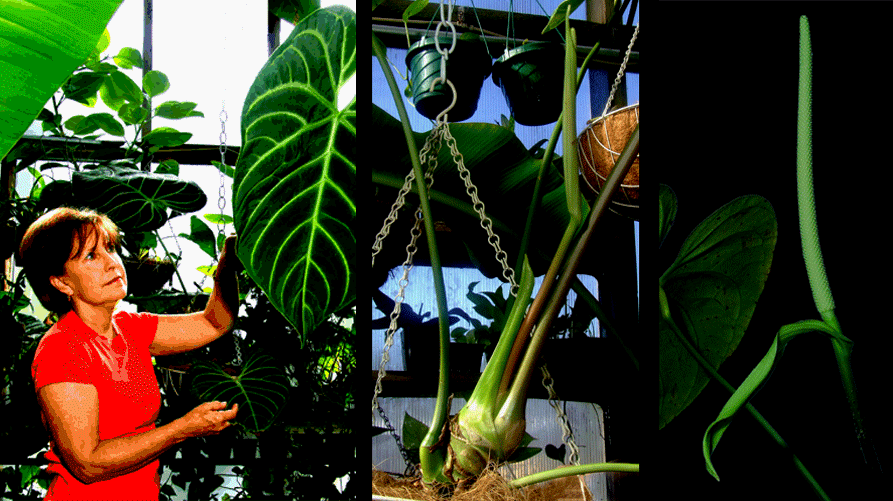
Photos ©
2006/2007 Steve Lucas
Growth of an inflorescence
See Page 2 for the definitions of botanical terms used in this description.
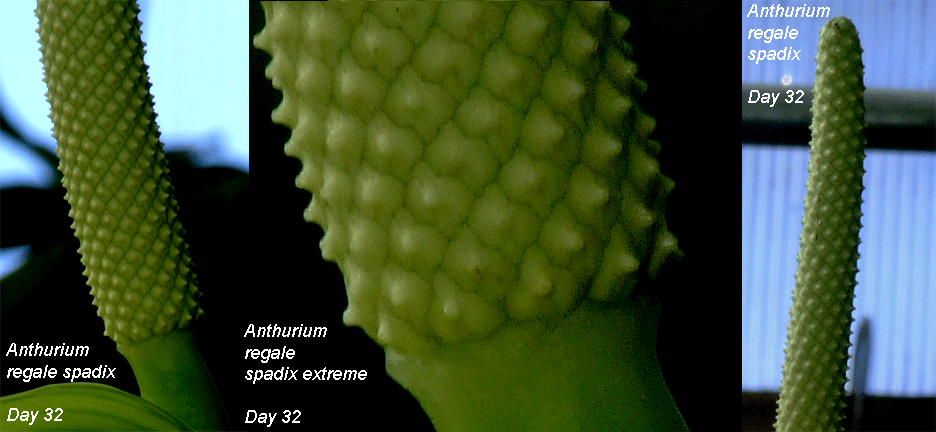
Today Dr. Croat
responded, "Since
we know so little about the pollination biology of Anthurium I suspect
nearly anything is possible. I am surprised that your nectar was not
sugary but that is interesting. You should write up your observation
for publication in the Newsletter or in Aroideana depending on how
convincing a story you can tell. You probably know more
about this species now than anyone else. Could you make some
measurements on your spathe and spadix. We will eventually need a
complete description of that species as well, even though it is not from
Ecuador."
I make absolutely no claim to knowing very much about this
species. I began this project to try to learn. But I am very curious about what I've observed.
What little I know I have learned with the help and input of several
others including Dr. Croat, Julius Boos, LariAnn Garner and several
others who are very knowledgeable. These researchers and
collectors have given me their observations
almost daily during the past month. I
have been made aware of a few other Anthurium regale specimens in
North America currently in
flower. If you possess one of those aroids I would certainly be
interested in having you compare my observations
to your own plant and forward your comments. One field researcher who
has worked with Anthurium regale in Peru, but prefers not to be
named, made this comment to my question to Dr. Croat,
"Do
remember dogs and bugs have far greater numbers of olfactory cells than
we humans have. Consequently there is a good possibility that you are
not able to smell what an insect, bee or some other beetle might smell.
I have never noticed a smell with most of my anthuriums including
regale." So perhaps my
observation has no validity at all.
Dr. Croat's comment
about the species not being from Ecuador
was in regard to another project involving Ecuadorian species for which a number of us have
volunteered. The measurements of the spathe
and spadix Dr. Croat suggested have been made and recorded throughout
the photo history of the growth of this spathe and spadix.
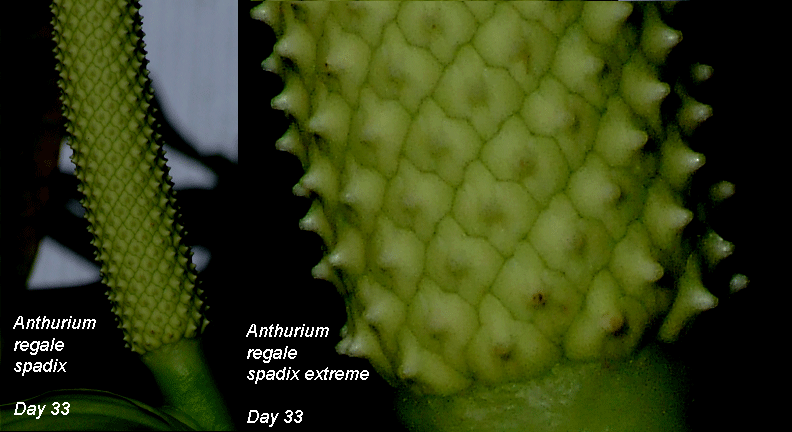
Day 33: No evidence of pollen production is yet visible. This morning I received an excellent "lesson" in Anthurium reproduction biology from "Dr." Julius Boos, "Concerning the fact that you and others cannot detect any scent on A. regale does not surprise me, as many Anthuriums (and other aroids) do not produce an odor that is readily detectable to the human nose! A few species are considered 'fragrant', and breeders are presently trying to 'work' these pleasant fragrances into Anthurium hybrids, and thus make them even more attractive to potential shoppers! Lets bear in mind that the human nose is one of the least sensitive! Think of the male moth that can detect a receptive female from miles away, but a human can smell nothing with his nose held inches away from a receptive female!"
Julius then went on to explain why my "theory" of the liquid not tasting "sweet" was of no consequence, "As to taste, the same 'syndrome' seems to apply-- what is 'unpleasant' to your taste may be lovely to others and/or insects, but maybe only to small beetles, tiny fruit-flies or ants! I can not help recalling a refreshing and sweetened drink we brew locally in Trinidad from tree-bark and fragrant seeds, which we call 'mauby', it has what is to nearly every person (especially Americans!!) who as an adult tries it for the very first time, a revolting taste, certainly a distasteful bitter after-taste to the first 'sweet' taste, but to us Trinidadians who have been drinking it from youth, there is nothing better!
Again, "Dr." Julius makes his point understandable, clear and vivid! He then went on to explain that some pollinators are drawn only to very limited scents and some to only limited colors. Regarding my query to Dr. Croat as to the plant's "rarity" in nature, he commented, "I believe that much more observation in the wild will be needed before we can speculate on this. This plant may not be, or may not have been at all rare in the wild in recent times past, and may, under natural conditions, produce a full infructesence. Man`s destruction of its natural habitat might be responsible for its present scarcity (if in fact it is scarce in its habitat!) and also may have caused the reduction or lack of natural pollinators."
Then Ted Held forwarded
this observation,
"Here
is a story related to me by a fellow keeper of Cryptocoryne, a
family of marsh aroids. I mentioned to him that I could never detect
any discernible scent in these flowers except for a sort of generic
"musty" smell, which permeates marsh plants and their containers. He
mentioned that lack of scent had been his experience too. But he
also said that when he removed flowers to outdoors for photography
(trying for natural lighting) that the flowers would attract insects
from his backyard almost immediately. The moral is that what you can
detect might be different from what an insect (or other pollinator)
might be able to detect. Maybe this is a corollary to the
stench emitted by many aroids. What is stench to us may seem
like a T-bone steak to an insect."
So much for my
theory!
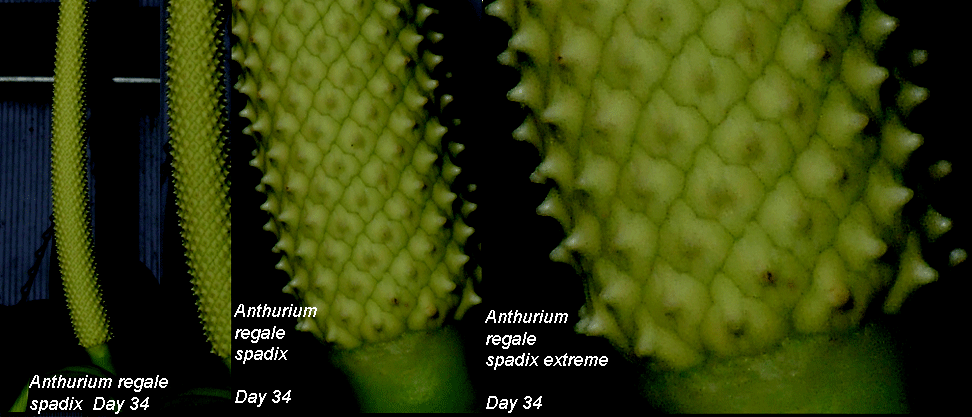
Day 34: No visual evidence of male anthesis. Approximately one week ago Dr. Croat mailed a copy
of his paper "Flowering Behavior of the Neotropical Genus Anthurium
(Araceae)". I have been attempting to absorb even a bit of his
years of observing this group of aroids. In his latest note
Dr. Croat made these comments which I believe will be useful as the
next phase of this anthurium species' reproduction behavior reveals itself:
"If
you are past female anthesis it should start to go through its male
phase and stamens should start emerging, typically from the base and
working upward. Here is where you can really make a contribution
because the pattern of emergence is often species specific. Read my
discussion of flowering behavior that I sent. Make note of the
first emergence and follow each day. Usually one or two lateral
stamens emerge, later the anterior one and still later the lower
anther. Make note of the pattern and the extent to which they are
emerged. If they are very emergent they will also retract
after about 24 hours. There are all kinds of variations and this
species has never been studied to my knowledge."
This afternoon "Dr." Julius made these observations, "I had noticed the stigmas, the little 'nipples' at the center of each individual flower in the middle of the four scales of the perigones, (the ''tip of the perigone'' is how you referred to it) are turning brown and drying up for a few days now. But since I expected this, I have not mentioned it. It started at or near the bottom of the spadix and signals the end of the female anthesis on each individual flower. So we can expect once male anthesis begins, perhaps in a couple days, it will be at these flowers we may first observe pollen. Look for the yellowish or cream or white powder of pollen near the bottom of the spadix, then put a good hand lens on that area, you should then be able to see the male parts (stamens) as described by Tom Croat. This should take place for a length of time, starting at or near the bottom and working itself upwards. When the uppermost flowers have completed producing their pollen both anthesis (male and female) will be over, and we must then wait and see if you get lucky... and if in this species may produce a few viable seed in a very few fruit. If not, the whole infloresence will die and drop off shortly after male anthesis is completed." If you look at the center perigone in the second row from the bottom on the extreme photo you can see the drying stigma as Julius described. It is in this region we will be looking for the first appearance of stamens.
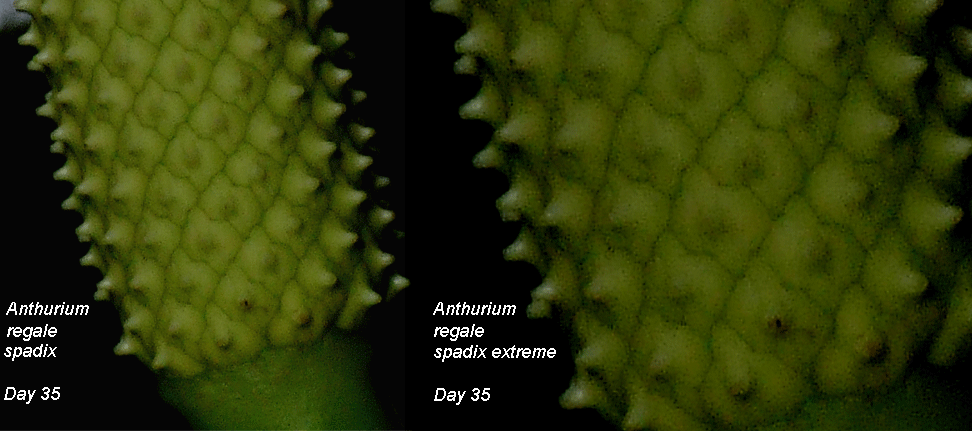
Day 35: No visual evidence of stamens or pollen. I
received an email from an anthurium grower in Hawaii two days
ago with an interesting photo attached. This grower
successfully grows many rare anthuriums and has a large
number of Anthurium veitchii that regularly produce seeds.
The photo was of a fruit fly pollinating one of her Anthurium
veitchii. I often have fruit flies (likely a different
species) in my atrium. So I have now placed several wedges of
fruit at the base of the Anthurium regale to attract insects.
They're all over the fruit! But apparently "my" fruit flies
don't care for the scent of the Anthurium regale! Not a
single one is landing on the spadix. The photo on the right is
an extreme magnification done in an attempt to view any hint of
stamens.
